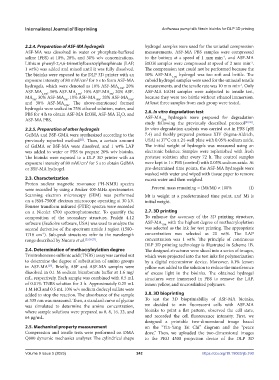Page 250 - IJB-9-5
P. 250
International Journal of Bioprinting Antheraea pernyi silk fibroin bioinks for DLP 3D printing
2.2.4. Preparation of ASF-MA hydrogels hydrogel samples were used for the uniaxial compression
ASF-MA was dissolved in water or phosphate-buffered measurements. ASF-MA PBS samples were compressed
saline (PBS) at 10%, 20%, and 30% w/v concentrations. to the bottom at a speed of 1 mm min , and ASF-MA
-1
Lithium phenyl-2,4,6-trimethylbenzoylphosphinate (LAP, EtOH samples were compressed at speed of 2 mm min .
-1
1 wt%) was added and mixed until it was fully dissolved. The compression test could not be performed because the
The bioinks were exposed to the DLP 3D printer with an 10% ASF-MA 2.5% hydrogel was too soft and brittle. The
exposure intensity of 80 mW/cm for 5 s to form ASF-MA cuboid hydrogel samples were used for the uniaxial tensile
2
hydrogels, which were denoted as 10% ASF-MA 2.5% , 20% measurements, and the tensile rate was 10 mm min . Only
-1
ASF-MA 2.5% , 30% ASF-MA 2.5% , 10% ASF-MA , 20% ASF- ASF-MA EtOH samples were subjected to tensile test,
5%
MA , 30% ASF-MA , 10% ASF-MA 10% , 20% ASF-MA 10% , because they were too brittle without ethanol immersion.
5%
5%
and 30% ASF-MA 10% . The above-mentioned formed At least three samples from each group were tested.
hydrogels were soaked in 75% ethanol solution, water, and
PBS for 4 h to obtain ASF-MA EtOH, ASF-MA H O, and 2.6. In vitro degradation test
2
ASF-MA PBS. ASF-MA 10% hydrogels were prepared for degradation
study following the previously described protocol [29,30] .
2.2.5. Preparation of other hydrogels In vitro degradation analysis was carried out in PBS (pH
GelMA and BSF-GMA were synthesized according to the 7.4) and freshly prepared protease XIV (Sigma-Aldrich,
previously reported method . Then, a certain amount USA) at 37°C on a 24-well plate with 0.05% sodium azide.
[25]
of GelMA or BSF-MA were dissolved, and 1 wt% LAP The initial weight of hydrogels was measured using an
was added to water or PBS to prepare 20% w/v bioinks. electronic balance. Samples were replenished with fresh
The bioinks were exposed to a DLP 3D printer with an protease solution after every 72 h. The control samples
exposure intensity of 80 mW/cm for 5 s to obtain GelMA were kept in 1× PBS (control) with 0.05% sodium azide. At
2
or BSF-MA hydrogel. pre-determined time points, the ASF-MA hydrogels were
washed with water and wiped with tissue paper to remove
2.3. Characterization excess water and then weighed.
Proton nuclear magnetic resonance ( H-NMR) spectra
1
were recorded by using a Bruker 400-MHz spectrometer. Percent mass remaining = (Mt/Mi) × 100% (I)
Scanning electron microscopy (SEM) was performed Mt is weight at a predetermined time point, and Mi is
on a JSM-7500F electron microscope operating at 30 kV. initial weight.
Fourier transform infrared (FTIR) spectra were recorded
on a Nicolet 6700 spectrophotometer. To quantify the 2.7. 3D printing
composition of the secondary structure, Peakfit 4.12 To enhance the accuracy of the 3D printing structure,
software (SeaSolve software, USA) was used to analyze the ASF-MA 10% with the highest degree of methacryloylation
second derivative of the spectrum amide I region (1580– was selected as the ink for test printing. The appropriate
1710 cm ). Sub-peak structures refer to the wavelength concentration was selected as 20 wt%. The LAP
-1
range described by Nucara et al. [23,26,27] . concentration was 1 wt%. The principle of continuous
DLP 3D printing technology is illustrated in Scheme 1B.
2.4. Determination of methacryloylation degree The designed structures were sliced into a series of images,
Trinitrobenzene sulfonic acid (TNBS) assay was carried out which were projected into the test inks for polymerization
to determine the degree of substitution of amino groups by a digital micromirror device. Moreover, 0.1% lemon
in ASF-MA . Briefly, ASF and ASF-MA samples were yellow was added to the solution to reduce the interference
[28]
dissolved in 0.1 M sodium bicarbonate buffer at 1.6 mg/ of excess light in the bioinks. The obtained hydrogel
mL, respectively. Each sample was combined with 0.5 mL structures were immersed in PBS to remove the LAP,
of 0.01% TNBS solution for 3 h. Approximately 0.25 mL lemon yellow, and uncrosslinked polymers.
1 M HCl and 0.5 mL 10% w/v sodium dodecyl sulfate were
added to stop the reaction. The absorbance of the sample 2.8. 3D bioprinting
at 335 nm was measured. Then, a standard curve of glycine To test the 3D bioprintability of ASF-MA bioinks,
was simulated to determine the amino concentration, we decided to mix fluorescent cells with ASF-MA
where sample solutions were prepared as 0, 8, 16, 32, and bioinks to print a flat pattern, observed the cell state,
64 µg/mL. and recorded the cell fluorescence intensity. First, we
designed a printable two-dimensional image based
2.5. Mechanical property measurement on the “Yin-Yang Tai Chi” diagram and the “peace
Compression and tensile tests were performed on DMA dove.” Then, we uploaded the two-dimensional images
Q800 dynamic mechanics analyzer. The cylindrical shape to the PRO 4500 projection device of the DLP 3D
Volume 9 Issue 5 (2023) 242 https://doi.org/10.18063/ijb.760

